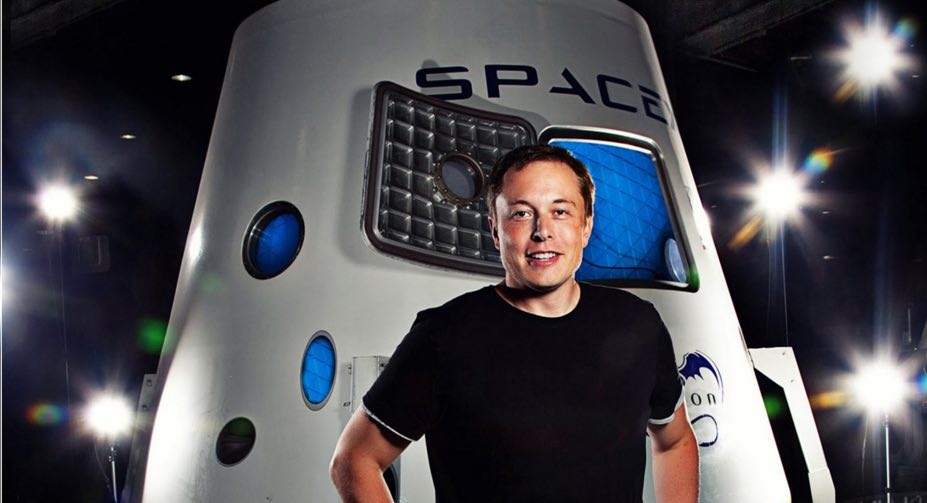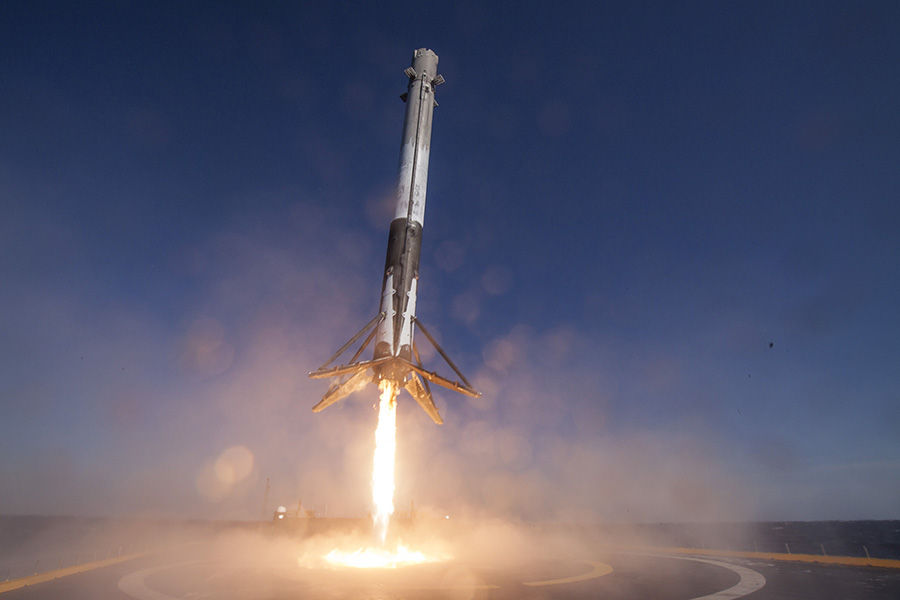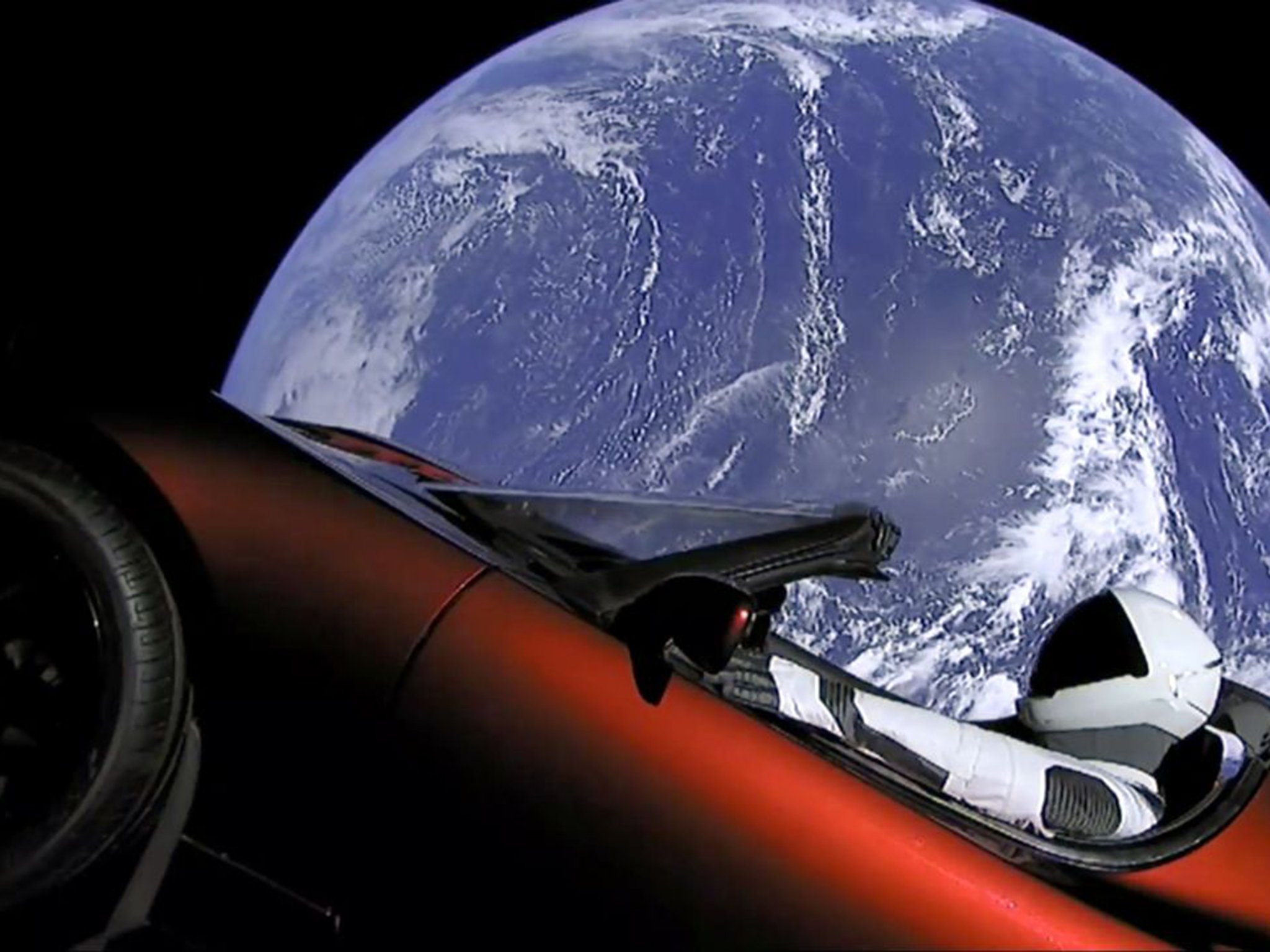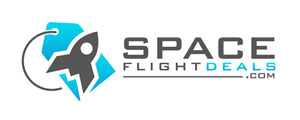SpaceX
Of the three biggest commercial players in the race to put people into space, it is SpaceX which is surely the most active. In a competition where all three companies are headed by publicity hungry business tycoons, it is also surely Elon Musk, SpaceX’s charismatic founder, who is ahead on worldwide media coverage too. All are fond of self-promotion, with Sir Richard Branson being particularly fond of a PR friendly publicity stunt. But even he has never gone so far as to launch a car into space!
So just who is Elon Musk, and how has he arrived at the forefront of these momentous times in the history of commercial space flight?

The History of SpaceX
Born in Pretoria, South Africa in 1971, Mr Musk currently resides in the Unites States. He is a triple passport holder, entitling him to citizenship in the country of his birth, Canada and the United States. Most people regard him as an American, given that this is his current country of residence, as he has lived there since 1990, and all his immense business success has been achieved in the US. His various commercial ventures have earned him spectacular fortune. By the close of 2018, Elon Musk was estimated to be worth a cool $23 billion and is without doubt one of the hundred richest people on the planet.
PayPal
But it all began around the turn of the Century. Elon Musk’s first mega company was PayPal – the electronic payment service which was fundamental in the commercial success of the internet. Originally set up by a quartet of tech savvy entrepreneurs in 1998, it was originally known as Confinity. Elon was the CEO of a rival technology start-up called X.com, and he instantly spotted the commercial possibilities of utilising this new money transfer service as a means of funding online transactions. In 2000, he snapped up the company (officially it was a merger). Shortly afterwards, he re-named his company after its new flagship money service, and it became known as PayPal.
The service was an overnight success, becoming a crucial payment method for the popular worldwide online marketplace eBay. So successful was it that in 2002 PayPal was launched on the New York Stock Exchange, and the resulting share sales raised over $60 million. But even this was dwarfed very shortly afterwards. In July the same year, eBay decided to buy the entire company outright for $1.5 billion. It was this windfall which was the foundation for Elon’s subsequent ventures and continued headline making success.
Tesla
In addition to SpaceX, which Elon Musk founded in 2002 using proceeds from his lucrative PayPal launch, there are several further strings to his bow. He created his Tesla venture in 2003. This electric powered car and solar panel technology company is based in California. The plan is to design cars which can be driven entirely by electricity via powerful batteries, yet still be affordable when compared with conventional internal combustion engine vehicles.
Like SpaceX, Tesla is another long term, slow developing project. Car sales have been disappointing, but at the time of writing, things do seem to be moving in the right direction. Sales of the new Model 3 are particularly encouraging, with a total of over 200,000 expected to be sold in the 2018 financial year – almost as many as the total sold over the previous fifteen years. As a marker of this upturn in fortunes, Tesla’s market share in the United States exceeded that of established car manufacturer Mercedes-Benz in 2018. The new Model 3 Tesla is due to be introduced to the United Kingdom in 2019.
However, the target of making cars affordable to the everyday driver has yet to be realised. The focus remains on high performance prestige models, although an affordable hatchback model is promised for the worldwide market within five years.
Hyperloop and The Boring Company
But even this is not the end of Musk’s new technology ventures. At times his ambitions can seem almost sci-fi in nature, but it would be unwise to bet against him. His proposed Hyperloop fast transportation system is designed to provide futuristic high speed public transport for people via pressurised tubes.
Meanwhile his ironically titled The Boring Company involves another public transportation method, this time based on a low cost and high speed tunnelling network. This does seem closer to a practical solution for everyday city commuters. Indeed, a test tunnel has already been bored on the SpaceX estate in California, and the very first tunnel available for possible public use was opened for media presentations in December 2018, under the streets of Los Angeles.
The Development of SpaceX
With all this activity already in hand, it seems hard to believe that the hyperactive mogul would have any time left for what now seems to be his most famous ongoing venture. Yet Musk’s SpaceX has gone from strength to strength and is by far the most successful in terms of practical achievements so far.
SpaceX has already launched well over a hundred different rockets into space, both for its own purposes and also as a result of commercial deals and contracts with other space operators including NASA. It is estimated that these contracts have been worth around $12 billion in revenue to the company. This finance is essential given the high costs of research and development necessary to design and build the new rockets and spacecraft. Even Elon Musk’s vast resources have their limits.
Founded less than two decades ago, SpaceX launched the first privately funded rocket to achieve earth orbit more than a decade ago, in 2008. At the time of writing, neither of its main commercial rivals has achieved this feat, and only one has any plans to do so. This is a clear demonstration of how far ahead SpaceX is when compared to its competitors.
And yet this success was far from a one off achievement. The company has a consistent record of development. Less than a year later, in July 2009, it launched its first commercial satellite into Earth orbit. In 2012, it became the first private company to send a spacecraft to the International Space Station (ISS). By the end of 2018, SpaceX had sent a total of sixteen different re-supply missions to the ISS – providing essential support for NASA which has not had a viable means of its own to provide these services since the decision to decommission its remaining Space Shuttles in 2011. The only alternative supply vehicle is Russia’s ageing Soyuz rocket, first developed more than fifty years ago in the 1960s.
In addition to becoming the established ferrying service to the ISS, SpaceX has made further strides beyond the stratosphere. In December 2013, it sent its first satellite into high Earth orbit. This higher altitude is known as geo-synchronous orbit, allowing satellites to orbit at the same speed as the Earth is spinning. This makes the satellite appear stationary when viewed from Earth. This is important for several purposes, including Earth observation services and providing satellites for the various navigation systems used by earth bound citizens, such as GPS and the new EU system Galileo.
The company has also made great use of its re-useable rocket technology. This is important in keeping costs to a minimum. It has successfully landed its rockets back on land (2015) and on a sea platform (2016). It has also returned a previously used rocket (2017) and it re-launched a previously used cargo spaceship later the same year.

Its workhorse rocket is the Falcon 9. This has gone through many incarnations and upgrades. In total, Falcon 9 rockets have made over fifty flights into space. The latest version at the time of writing is the Falcon Heavy, which is the biggest rocket designed since the world’s largest ever, the Saturn V, built to carry the Apollo astronauts to the Moon.
The Falcon Heavy is by far the most powerful rocket around today, providing twice as much lifting power as any alternative currently available. It can launch a payload of up to 64 metric tons (over 140,000 lbs) into orbit. This mass is equivalent to that of a fully loaded 737 jet aircraft, and the fact that it is partially re-usable means that this can be done at around a third of the cost of its main competitors’ rockets.
The Falcon Heavy is a two stage rocket. The first stage is the re-usable part, consisting of three engine bodies, each containing nine Merlin rocket engines. Together, these 27 engines can produce over 5 million pounds of thrust, equivalent to that produced by around eighteen 747 jumbo jets. The second stage is the same as that used on the standard Falcon 9 rocket. This is used to power its satellite or cargo payload into Earth orbit.
But having a powerful, reliable rocket is only part of the story. You also need a decent spacecraft to fit on the top too. SpaceX already uses its Dragon capsule for this purpose – it has already run more than a dozen successful re-supply missions to the ISS. For future manned flights, it is proposed to convert this vehicle for human use. The Dragon capsule is therefore designed to be able to carry up to seven astronauts into Earth orbit and even beyond.
The first crewed mission to the ISS is planned for April 2019, with two NASA astronauts already in training for the mission. This will be the first non-Soyuz manned flight to the ISS since NASA’s Space Shuttle was retired in 2011.
Publicity and Promotional Stunts
The commercial space industry is chock full of publicity hungry personalities with seemingly astronomical ambitions. Even so, Elon Musk is surely the leader in what is a crowded field. Without doubt his most famous stunt was the launching of one of his Tesla cars into space on the inaugural flight of SpaceX’s new Falcon Heavy rocket in February 2018. The footage of Musk’s “Starman” mannequin apparently driving his gleaming red Tesla Roadster in space with the blue orb of the Earth as a backdrop is truly stunning.

However, regular announcements are made of future flights which don’t always materialise. In February 2017, it was promised that a privately crewed SpaceX Dragon spacecraft would fly to the Moon by the end of the following year. Now in 2019, the whole idea seems to have been quietly dropped for the time being. The latest announcement promises that a wealthy art collector, Yusaku Maezawa, will become the first private passenger to fly around the Moon in 2023. We’ll see.
Sometimes it seems as if the all hype and hyperbole can detract from the genuine achievements of the company. This is because it is undeniably the case that Elon Musk’s SpaceX has achieved more in terms of actually putting spacecraft into space than any of his competitors. In practical terms too, like those of actually delivering satellites into orbit and ferrying cargo to the ISS, SpaceX has no rivals. It may not suit Mr Musk’s big personality, but maybe it would be better to let his real achievements and startlingly rapid technological progress do the talking for him.
The Future
It may be difficult to discern the reality from the hype with Elon Musk, but one thing we can be sure of is that SpaceX is the real deal. You don’t get to sign contracts to carry NASA astronauts to the International Space Station, nor deliver vital civilian and United States military satellites into orbit unless you are a tried and tested operation. So there is no doubt that the future is bright.
In truth, SpaceX’s ambitions really do seem to go far beyond those of his main rivals. They seem focused on headline making space tourism and sub-orbital space flight. Elon appears to have his eye on the bigger picture. His co-operation with national governments and agencies is already proving very lucrative and has the potential to be more so in the future.
Perhaps we should continue to take his promises of imminent lunar expeditions and subsequent Mars colonies with a bucket of salt, but the undeniable truth is that SpaceX is making real, practical steps on the way to these seemingly remote goals.
In the end, the question as to which of the three main players will be the first to launch commercial passengers into space is anybody’s guess. Ultimately though, perhaps the old traditional folk tale has the ring of truth about it: SpaceX’s tortoise looks like the better bet for long term success than its rival’s hares.
